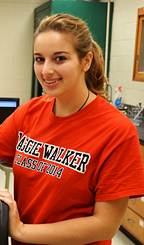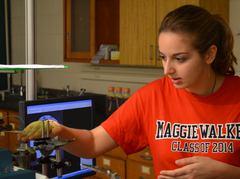
Name Samantha Marquez
- Education High School Student at Maggie L. Walker Governor's School in Richmond, Virginia
- Target Audience Middle School

Samantha Marquez is a tissue-engineering scientist, community leader and a high school student. Growing up with parents who both have careers deeply rooted in science definitely played a role in Samantha's science interests, but her realm of achievements are all her own. Read on to learn more about what it means to be a young inventor and innovator and why Samantha inspires us!
I designed and created a structure called a Celloidosome.® Basically, it is a 3D capsule of living cells, organized in a core-shell structure, with the core being the template and the shell being living tissue. The Celloidosome® can be used in tissue engineering and many other fields of science. The Celloidosome® is important because it represents a revolutionary way to create three-dimensional tissue or cell clusters without having to deal with oxygen/nutrient transfer problems. This structure can eventually be used in a variety of medical treatments from treating severe burns to bone reconstruction, as well as healing and repairing damaged organs.
I started thinking about this project when I was in 7th grade. My science teacher gave us a project to go out and find articles about scientific research being done. Then, we had to come up with ideas about what the next steps would be for the scientists conducting the research. The article I found was in a scientific journal and was about an artificial spherical shaped crystal known as the Colloidosome. My idea was to use living cells, instead of inanimate colloidal particles, to build a similar structure for a whole new set of applications. That assignment was the start of a long road of research and testing to what is now my Celloidosome® project.
First, I had to figure out if there was an actual need or use for the Celloidosome. I went out and looked for practical applications that could use the Celloidosome. I started with islets which are clusters of cells. I was looking at islets specifically related to liver disease and I thought there has to be some solution to help the treatment process for this tissue damage. I decided that the way the Celloidosome could help was that it could transfer oxygen and nutrients to all the cells in the microtissue at the same time, increasing the viability of the Celloidosome and opening the door to new possibilities in 3D tissue engineering. That was my first real step in the invention and probably my greatest challenge throughout the process.
Anyone can invent anything. I could invent a toilet that flushes when I clap my hands, but does that really help the world - does it solve any problems? The difference for me is that innovators look at the world, figure out what is needed and create something that helps improve lives.
Asking questions! I have always had a curious spirit and the journey is far more rewarding for me than the end product.
I don't know about a specific moment when I decided I wanted to be an innovator, but I can definitely recall my first profound science experience fueled by natural curiosity. I used to love bugs and I would go and look for crickets and grasshoppers so I could try to figure out how they jump. I have this very vivid memory about seeing water bugs for the first time and it looked like they were just walking on the water. I asked my dad what they were doing and he said that their legs and feet have a unique surface tension with the water and they are able to run on top of the water's surface. I thought "oh, I'll try it too" and I ended up getting soaking wet. That early experience led me to think about science in a much more exciting and curious way.
I think it was the environment I grew up in - my dad is a chemist and my mom is a chemical engineer, so science has always been a part of my life. But, if I had to name a specific person, it would be my eighth grade science teacher, Mrs. Estes. She really introduced me to scientific research and encouraged me to participate in my first science fair.
 I like to be a regular teenager every once in a while - I like the movies and hanging out with my friends. I also really like community service and giving back to those around me. One specific event that I really enjoyed was a lecture I gave at the Society for Hispanic Professional Engineers, which hosted 400 high school students for the event. The reason it was so meaningful for me is because I felt like I was really able to connect with the students and show them how exciting science can be, as well as illustrate that you don't have to wait until you're done with school to be an innovator. You can ask questions now and start exploring what problems there are in the world right now. For me community service is not about school requirements, but more about love and justice for the community and making other people care because you care. I love this particular quote from Ghandi, "the best way to find yourself, is to lose yourself in the service of others."
I like to be a regular teenager every once in a while - I like the movies and hanging out with my friends. I also really like community service and giving back to those around me. One specific event that I really enjoyed was a lecture I gave at the Society for Hispanic Professional Engineers, which hosted 400 high school students for the event. The reason it was so meaningful for me is because I felt like I was really able to connect with the students and show them how exciting science can be, as well as illustrate that you don't have to wait until you're done with school to be an innovator. You can ask questions now and start exploring what problems there are in the world right now. For me community service is not about school requirements, but more about love and justice for the community and making other people care because you care. I love this particular quote from Ghandi, "the best way to find yourself, is to lose yourself in the service of others."
I really have liked science for as long as I can remember. A new field that I've been exploring is psychology. I love the correlation of psychology and biology - or the relationship between mind and body.
Look at the science classes that your school has to offer. It's even more important to take a diversity of classes to be well rounded. I know that not all schools offer engineering, but find a course you can connect with and you find interesting.
Start talking to your teachers about research projects - which could be as simple as doing a baking soda project at home. Really, anything that gives you an introduction to the scientific process is helpful. You could join a science club and if your school doesn't have a science club - talk to your teachers about starting one.
Right now, the most intimidating thing for me is college applications. I feel like it is just looming over me right now and I will be really thankful when they are all submitted. What I'm really excited about though, is the change that this coming generation of leaders will be able to achieve. Leadership isn't about ability, it's about responsibility and I think that there are a lot of leaders being molded that will be making positive changes for society.
What really matters in life is a being a responsible citizen. I really want to be remembered as is an activist for positive change in the world.
7 - The number of patents Samantha has
10 - The number of trademarks Samantha has
5 - The number of top tier universities Samantha has completed internships with
11 - Samantha's age when she started her Celloidosome research
1 - The place her research was awarded recently during the International Space Olympics
3 - The number of languages Samantha speaks - English, Spanish and Mandarin Chinese
16 - Her age at the time of our interview
Abdul Yassine is a senior biology major and soccer player at Southern M…
Melissa Wallace is an SMU alumna who studied Mechanical Engineering. Sh…
Do you love music and science? Do you think you have to choose just one…